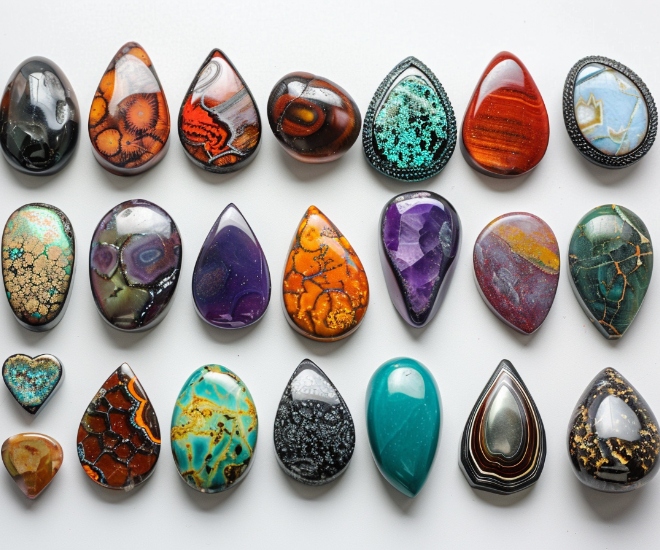
With so many options available, gemstones and jewellery can be overwhelming to understand the various types of materials used in crafting these pieces. As you embark on your journey to purchase online jewelry, we invite you to explore Ana Luisa first, where you can find exquisite collections created with sustainability in mind. In this engaging walkthrough, we will guide you through different categories of jewellery materials and provide expert advice on their care.
A Guide to Popular Jewellery Metals
Jewellery metals play a crucial role in the aesthetics as well as the durability of any piece. Some of the most popular metals used in jewelry making are gold, silver, platinum, and stainless steel. Let’s start by exploring each one:
Gold

Adored for its timeless elegance and versatility, gold has been a go-to material for jewelry makers and wearers alike throughout history. Pure gold (24 karats) is soft and malleable, which makes it unsuitable for everyday wear. Therefore, alloys of gold containing other metals like copper or silver are more commonly crafted into jewelry. The purity and color of gold are measured in karats – 14K, 18K, and 22K being the most common variations available. Proper care for gold jewelry includes regular cleaning with gentle soap and water and storing it separately to prevent scratches.
Silver
Silver’s affordability, along with its gleaming appeal, has made it a popular choice among various cultures. Sterling silver, composed of 92.5 percent pure silver and 7.5 percent other metals, is preferred over pure silver due to its increased strength and durability. To care for silver jewelry, gently clean it with a soft cloth, avoid exposing it to chemicals or extreme humidity, and store it in an airtight container to prevent oxidation or tarnishing.
Platinum
Known for its remarkable strength and resistance to wear, platinum is a luxurious and sought-after metal in the world of fine jewellery. It has a slightly higher price point than gold and silver due to its rarity and exceptional durability. To maintain its luster, you can clean platinum jewelry with mild soap and water, while storing it separately from other metals to avoid scratches.
Stainless Steel
Fast gaining popularity due to its stylish industrial look and affordability, stainless steel is a durable and low-maintenance option for contemporary designs. Its hypoallergenic nature makes it an excellent choice for people with sensitive skin. Care for stainless steel pieces involves regular cleaning with warm water and mild soap, followed by drying it thoroughly before storage.
In addition to these classic jewellery metals, some fashion-forward retailers like online jewelry designer Ana Luisa offer collections that use alternative materials such as brass or recycled gold-plated sterling silver to sculpt exquisite, eco-friendly designs without compromising on style or quality.
Alternative Materials: Ceramic, Glass, Wood, and More
When it comes to more unique jewellery materials, ceramic, glass, wood, and gemstones stand out as popular options that can add a touch of distinctiveness to any ensemble:
Ceramic
Ceramic jewellery features a modern elegance that brings together exceptional durability and lightweight comfort. Known for its bright white appearance and scratch-resistant surface, caring for ceramic jewellery is simple – just clean it with mild soap and water periodically to maintain its pristine look.
Glass
Offering a multitude of colours, shapes, and styles, glass jewelry is often handcrafted by skilled artisans using techniques like lampworking and glassblowing. Store glass pieces separately from other materials to reduce the risk of breakage, and clean them with warm soapy water to keep their lustrous sheen intact.
Wood
Wooden jewellery brings an organic warmth and texture to your collection. From intricate carvings to simple beads, wood can be shaped into various forms and patterns. To care for wooden ornaments, use a soft, damp cloth to remove dirt or residue, and periodically apply a light coat of natural oil to preserve the wood’s finish and prevent it from drying out.
Gemstones

A world of brilliant hues and dazzling sparkle lies within the realm of gemstone jewellery. Each gemstone has its unique properties and requires specific care methods:
- Diamonds: The toughest gemstone can still be chipped or scratched if not handled properly. Clean diamonds with a gentle soap and water solution, and store them individually wrapped in soft cloth.
- Pearls: The delicate surface of pearls calls for extra precautions. Wipe them down after each wear with a soft cloth, avoid using abrasive cleaners or harsh chemicals, and store them separately to prevent damage.
- Other gemstones: Cleaning most colored gems should be done with caution. Use a soft brush with lukewarm water and mild soap, then rinse thoroughly before storing them individually to avoid scratches.
With this comprehensive guide to different types of jewellery materials and their care, you can confidently make informed decisions while shopping for your next statement piece or maintaining the ones you already own.
Discover a world of design possibilities with Ana Luisa’s curated collections that celebrate sustainable craftsmanship and modern aesthetics fused into timeless creations. You’re sure to add one, two, or even more than three new pieces to your jewellery collection.
For the latest in luxury jewellery reads, click here.

